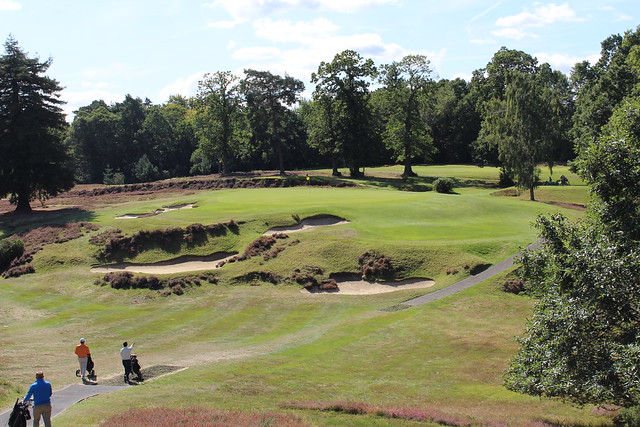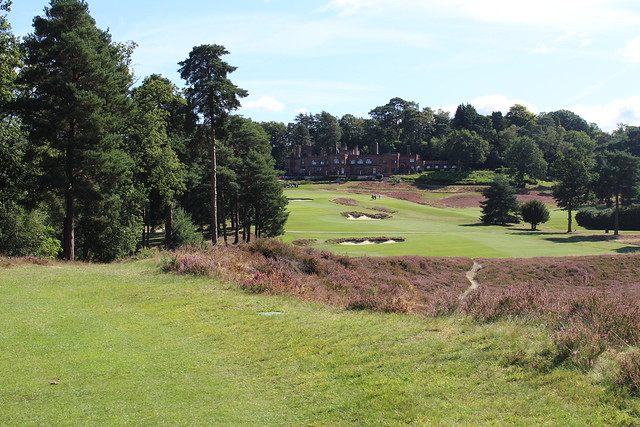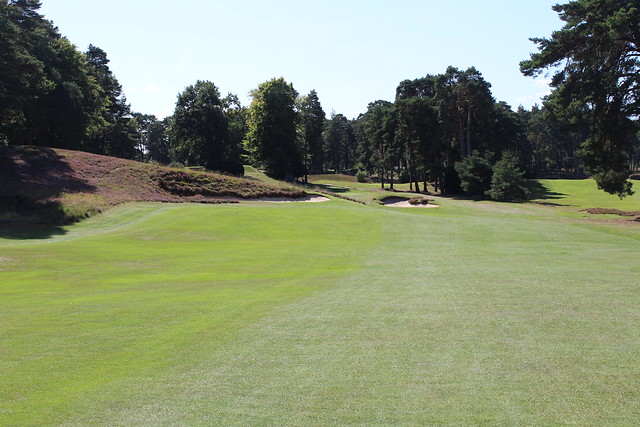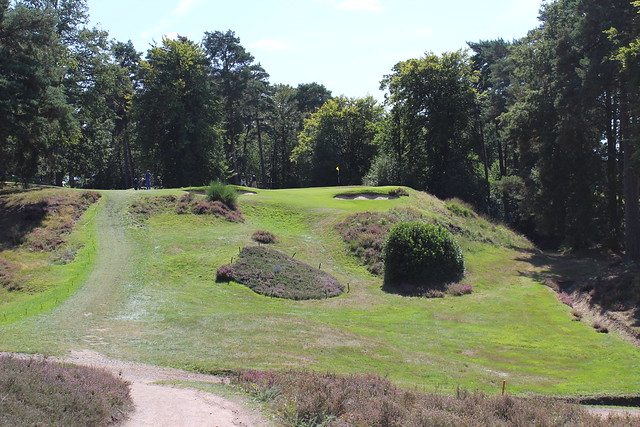Entry to the St. George's Hill Golf Club requires the visitor to pass through a guard gate, something that is rare in the United Kingdom. Once you pass muster with the resolute guard wearing his peaked hat, the barrier rises and you granted entry into this tony club, which is part of a 964 acre private estate located in Weybridge, Surrey, 25 miles from Buckingham Palace. To give some context on how ritzy the neighborhood is, two Beatles have lived there: John Lennon lived at St. George's Hill at the peak of his career and Ringo Starr was a resident in the mid 1960s, buying his first home near John on the exclusive housing estate.
Its 440 homes are set in a fantasy-level country setting dominated by tall pine trees and towering walls of rhododendrons. You and I couldn't afford to live there--unless you have £10m to spare--as the estate is popular among the global elite. In addition to British aristocrats, the locale is popular among Russian oligarchs, movie stars (Kate Winslet being one example), and Asia's super-wealthy looking to buy property overseas as a store of value. After I got home I went and looked at some of the real estate listings for homes in St. George's Hill and these people aren't messing around. The homes feature reception halls, gyms, drawing rooms, walled gardens, indoor pools, staff accommodations, leisure complexes, and six car garages. As Phil Rizzuto used to say, "Holy cow!"
The architect Fred Hawtree says that St. George's Hill was the prototype of English golf and country club estate development, the earliest of its kind. In fact, I believe it was the first joint golf-housing development ever built anywhere. It is tastefully done with the houses mansions set back, and few in number.
The fortress style clubhouse seen above a sea of heather on the closing hole
The golf course was designed by H. S. Colt and it is a gem. To establish Colt's credentials, look no further than Pine Valley. When George Crump was looking for assistance designing Pine Valley it was Colt he called on.
Welcome to St. George's Hill, which demands strong and straight tee shots from the get go. The first hole plays up a broad hill
The course has three sets of nines, although the Colt designed holes are the Red and the Blue, which is the course I played. The first hole sets the tone for the day and is not for the faint of heart. The card shows yardage of 382 yards, but the hill is steep and the green sits at the top. Tom Doak describes it perfectly in his original rendition of The Confidential Guide: "A smash across a valley and the entrance road to a rising fairway, with a saddled green at the top of the opposite ridge."
The defining characteristics of St. George's Hill are: 1) Its visually stunning beauty; 2) Elevated greens with false fronts; 3) More than its fair share of hump backed or undulating greens and 4) Cross-bunkering set at obtuse angles to the line of play. The course was carved from dense forest in the 1910s. The back breaking work was done with horses, hand-operated crosscut saws, and one solitary wood-burning steam engine.
Like the first, the second hole is also a tester, of 458 yards, that plays over the rise of a hill to a fairway that is blind to the golfer. It then follows a hill that rolls down into a valley over a burn to an elevated, difficult green. Colt clearly wasn't a believer in the easy start.
Like the first, the second hole is also a tester, of 458 yards, that plays over the rise of a hill to a fairway that is blind to the golfer. It then follows a hill that rolls down into a valley over a burn to an elevated, difficult green. Colt clearly wasn't a believer in the easy start.
The Redan-style par three third hole, seen with a mansion poking out from behind the trees
The third is a long Redan style hole (birdie, thank you very much!).
An absolute beauty, this 272 yard par 4 comes early in the round as the 4th hole
The fourth captures the essence of the fun of playing a short par four hole. Colt says in his treatise, Some Essays on Golf Course Architecture, that the best form of a green for such a hole is a plateau, as he did here. He did fail to mention that it would be a heavily trapped plateau that falls off on all sides! What should be an easy hole becomes anything but when you stand over your wedge shot and contemplate hitting such a small target.
Magnificent cross-bunkering on the par four 5th hole shows that Colt was an artiste
The fifth shows off all of Colt's usual design characteristics in one hole. A par four of 388 yards, it requires a forced carry over heather and has substantial cross bunkering far short of the green. The design hoodwinks the golfer because it throws off their depth perception as they are hitting from a valley and the bunkering is above them. The green complex features a false front and more than mild undulations on the putting surface. Add to that the fact that it is eye candy and it's no surprise that it is a joy to play.
Colt describes his philosophy further in his book, "The longish carry, also, played up to the green over a cross-hazard, should on no account be omitted, as there is a neck-or-nothing thrill about it which is scarcely equaled by any other stroke, and which is enjoyed by golfers of any handicap, although playing it from very different ranges."
The 5th green, like many at St. George's Hill, features a characteristic false front
No doubt you've heard the expression first tee jitters to describe how nerves come into play when you hit your first tee shot of the day, especially if there are people watching or you are playing a special course for the first time. How about eighth tee jitters? As we walked off the 7th green I could hear my three friends start to proclaim superlatives as we walked to the 8th tee. It was one of the few times I was left slack-jawed on a golf course. I had nothing to say. It was mesmerizing.
The 179-yard par three eighth hole, unequivocally one of the great one shot holes in the world
Colt describes how he chooses green sites when laying out a new golf course, "The architect will next proceed to walk over the ground, taking with him a map on which he will note the position of any natural features. In the course of this examination he will record all those sites which Providence has intended mortals to putt on." It seems clear to me that divine inspiration hit him when he found the eighth hole at St. George's Hill. It is far and away one of the best par threes I have ever seen or played. You play from an elevated tee across a valley to a demanding green. As you can see, shots hit short are cause for serious worry. Tom Doak was impressed as well; from his Confidential Guide, " . . . the yawning bunker in front of the green was one of the most memorable hazards I've encountered in the game."
Robert Hunter, who knew a thing or two about golf architecture, having designed the Valley Club of Montecito and assisted Alister MacKenzie in the design of Cypress Point, features the 8th hole in his seminal work on how to design a golf course, The Links, in 1926. In his chapter on how to lay out hazards Hunter gave a special shout out to Colt's work here, describing it as a "bold hazard, well designed." The image from his book, below, shows that the hole was even more fierce in the early days with the gargantuan bunker sizes having been shrunk down over the years, no doubt to avoid complete debacles among member play. After all, these nice chaps have come out for a friendly game, and didn't sign up for lifetime imprisonment if in a hazard.
The 8th hole as seen in the 1920s with bunkers even more severe than todays
It was at this point during the round I began to scratch my head and wonder why St. George's Hill doesn't get more notoriety or exposure. It was one of the best golf courses I have ever played and I hadn't even seen ten of its holes yet. Bernard Darwin said about St. George’s Hill, “The prettiest courses are also the best and certainly one of the prettiest and best is St. George’s Hill.”
The closing hole of the front nine, a 389 yard par 4 playing up the hill. This doesn't suck
The deceptively placed cross bunker on the difficult par 4 tenth throws off the golfer's depth perception
The 434-yard par four tenth continues the theme of difficult starting holes should the golfer begin their round playing the Blue nine. Although the tee shot is very satisfying because you again play from the high hill near the clubhouse into a valley, the trouble begins on the second shot. Colt again employs his signature cross-bunkering, this time with half of it cut into a heather-covered hill.
Doak on the tenth hole: "The par 4 tenth is one of the best "Alps" type blind par 4 holes I've ever seen, with a diagonal ridge running across the fairway from left to right, so that the drive down the right-hand edge may get a glimpse of the green and a favorable kick off the slope to the left of the green, while the drive to the left makes the second shot inclined to kick into a bunker short right of the green." I can personally attest to the latter.
The large clubhouse was used as a military hospital during the First
World War, and during the Second World War the roof of the clubhouse was used
as an observation post for the home guard. A German bomb fell to the left of
the cross bunker on the tenth during the war. The crater it left is still there.
H. S. Colt, the master of the one shot hole. This is the 119-yard 11th
The par 4 sixteenth from the tee, with its fairway canted from right to left. The back nine is just as good as the front
St. George's Hill is a Colt classic that should also be a cult classic. There are other golf courses that have cult followings, namely, Sand Hills, National Golf Links of America, The Old Course at St. Andrews, Cruden Bay, and St. Enodoc. Sometimes you are so impressed by a golf course you don't just play and enjoy it, you join a cult; you've taken a vow to evangelize about it and defend it against heretics. I am now a St. George's Hill cult member. What a place. The visual beauty combined with such a classic, strategic golf course make this one of the finest places in the game to play.
And to show that I am serious about my new mission and I'm not just overly excited by my visit to the club, I am having some new custom made clothing made up. My usual attire when flying is a sharp looking crimson colored athletic-style track suit with matching jacket and trousers adorned with white stripes down the side. I'm having a custom set made up with an outsized version of the club's logo--which is a knight on a horse slaying a dragon--emblazoned on both the front and the rear. So if you ever notice me strutting through a busy airport shamelessly making my own personal fashion statement please feel free to stop me and allow me to tell you all about my St. George's Hill fetish in person. No selfies of the encounter, please.
And to show that I am serious about my new mission and I'm not just overly excited by my visit to the club, I am having some new custom made clothing made up. My usual attire when flying is a sharp looking crimson colored athletic-style track suit with matching jacket and trousers adorned with white stripes down the side. I'm having a custom set made up with an outsized version of the club's logo--which is a knight on a horse slaying a dragon--emblazoned on both the front and the rear. So if you ever notice me strutting through a busy airport shamelessly making my own personal fashion statement please feel free to stop me and allow me to tell you all about my St. George's Hill fetish in person. No selfies of the encounter, please.
I'm also still scratching my head on how the course has flown below the radar for so long and eluded my notice. Maybe I haven't been paying attention. Perhaps I focus too much on Golf Magazine's top 100 list. After all, Tom Doak did select it as one of his 31 favorite courses in the Gourmet's Choice section of his first Confidential Guide. The website Top100golf courses lists it as the 7th best in England and Darius Oliver in his Planet Golf book ranks it number one among English courses, although I would personally rank it second, behind only Sunningdale's Old Course. It's a travesty that this doesn't make the cut on Golf Magazine's list. It is better than at least three dozen courses currently ranked. By all measures St. George's Hill is a top shelf golf course.
The sign on the first tee shows the match formats on busy days. Something to be emulated, as it promotes fast play. Notice that 4 balls are in the minority
Over a lunch of tea sandwiches, filled rolls, and smoked haddock soup in the clubhouse after the round I had a chance to reflect back on how lucky I am to be able to play a course like this, to enjoy the camaraderie of good friends, and to appreciate all that life has given me. Every day is a gift and should be treasured.


















2 comments:
Delighted to be reading more course right-ups from you, and I wish you all of the best in recovery from your health battles.
Wonderful looking golf course here, and it must really fly under the radar if it hasnt been on yours after all these years. Whats your opinion on the golf publication course rankings these days? Are they still a true ranking, or has the influence of money or something else had an effect on which courses make the ranks?
Thanks, and all the best.
Thanks for the nice comments.
I think Golf Magazine is on the right track with new management at the top of the house and with Ran running their rankings. Their latest list is their best ever as evidenced by the fact that Yale, Myopia Hunt, Swinley Forest and St. George's Hill made the list. I think there will be less shenanigans with money and influence going forward especially from rich real-estate developer-politician owners. The Golf Digest ranking isn't credible and never has been been. Their methodology is wrong, too many raters, wrong criteria, etc. The work they do a top100golfcoursess.com is quite good and the site is well curated.
Post a Comment